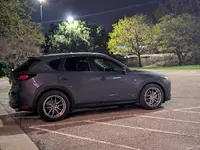There are a lot of variables, but will share some thoughts.I'd like to hear more of your thoughts on how your CX-5 drives with this set up. I'm due for a new wheel and tire set up, and I am currently torn between sticking with the stock 19" size or doing a -1 down to a 18" like you have in order to save wheel weight, and getting a bit more sidewall. Thanks in advance for any input.
The OE setup is HEAVY and you feel it in terms of ride quality and responsiveness to throttle and brake input.
The OE tires are quite "soft" which buys you a litlte bit in terms of "impact harshness" (not bad with the OE setup). The OEs are rated quite poorly in all aspects on Tire Rack. Not at all a sporty tire.
My new setup is both much lighter and the tires are designed to be higher performance. So, the opposite of the above: feels more responsive, definitely feel more grip in corners. I drove it pretty fast on a horrible highway last night and it was super planted and confidence inspiring.
One thing I'm going to keep an eye on: seems like I had a bit more "steering feel" with the original setup. Oh wait, skip that, the dealer had cranked the tire pressure up to near 40psi. Things got really soft when I dropped it to the 35psi spec.
The aesthetics are personal preference. I like the way it looks. Some people like larger wheels and I get it, but I tend to run -1 on most of my cars for the weight/ride benefits even if you lose a hair of steering sharpness in the bargain.
Hope that helps.





